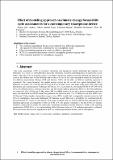| dc.contributor.author | Corcoran, Peter | |
| dc.contributor.author | Andrae, Anders S.G. | |
| dc.contributor.author | Samuli Vaija, Mikko | |
| dc.contributor.author | Garcia, Catherine | |
| dc.contributor.author | Dechenaux, Elisabeth | |
| dc.date.accessioned | 2014-09-09T12:31:05Z | |
| dc.date.available | 2014-09-09T12:31:05Z | |
| dc.date.issued | 2014 | |
| dc.identifier.uri | http://hdl.handle.net/10379/4522 | |
| dc.description | Article | en_US |
| dc.description.abstract | Life cycle assessments (LCA) of consumer electronics and beyond are usually performed and reported very differently. As a result it is often difficult to assess the robustness, variability and transparency of reported LCA case studies. The value of LCA for policy makers is in doubt if the present situation cannot be clarified and improved. As a part of the solution here for the first time state-of-the art LCAs for the same smartphone model are presented by two different organizations (Orange, OGE and Huawei, HuW) and the effect of different modeling approach is scrutinized. The system boundary, the studied product system and the cut-off were agreed beforehand. Still a difference of around 32% (29.6 kg and 39.2 kg) for CO2e baseline scores was found using same study object and Information and Communication Technology (ICT) Life Cycle Assessment (LCA) standard (ETSI TS 103 199, ETSI LCA), but different metrics, emission intensities, and LCA tools (software programs). However, the CO2e difference was reduced to 12% (29.9kg and 33.5kg) when OGE used HuW metrics for use phase power consumption and total mass, and when HuW used OGE metrics for gold mass and silicon die area. The 1% difference for these OGE scores (29.9kg and 29.6kg) implies that product category rules (PCR) would lead to comparable external results for full LCAs of smartphones when same background LCI database is used. However, a probability test confirmed that the present baseline CC results for one specific study object modeled with two largely different and independent LCA modeling approaches are comparable if both use ETSI LCA. The general conclusion is that the ETSI LCA strongly facilitates comparable CC results for technically comparable smartphone models. Moreover, thanks to the reporting requirements of ETSI LCA, a clear understanding of the differences between LCA modeling approaches is obtained. The research also discusses the magnitude of the CO2e reduction potential in the life cycle of smartphones. | en_US |
| dc.description.sponsorship | Orange; Huawei Technologies Co., Ltd.; Huawei Device Co., Ltd | en_US |
| dc.format | application/pdf | en_US |
| dc.language.iso | en | en_US |
| dc.rights | Attribution-NonCommercial-NoDerivs 3.0 Ireland | |
| dc.rights.uri | https://creativecommons.org/licenses/by-nc-nd/3.0/ie/ | |
| dc.subject | Climate change | en_US |
| dc.subject | Life cycle assessment | en_US |
| dc.subject | Modeling | en_US |
| dc.subject | Smartphone | en_US |
| dc.subject | Standardization | en_US |
| dc.title | Effect of modeling approach on climate change focused life cycle assessments for a contemporary smartphone device | en_US |
| dc.type | Article | en_US |
| dc.date.updated | 2014-09-09T12:16:34Z | |
| dc.description.peer-reviewed | Not peer reviewed | |
| dc.contributor.funder | |~|Other|~| | |
| dc.internal.rssid | 7080121 | |
| dc.local.contact | Peter Corcoran, Electrical & Electronic Eng, Room 3041, Engineering Building, Nui Galway. 2764 Email: peter.corcoran@nuigalway.ie | |
| dc.local.copyrightchecked | Yes | |
| dc.local.version | DRAFT | |
| nui.item.downloads | 2041 | |


